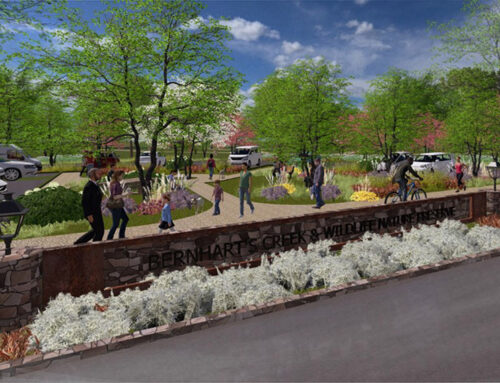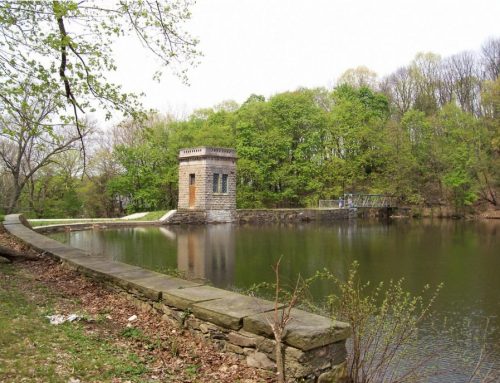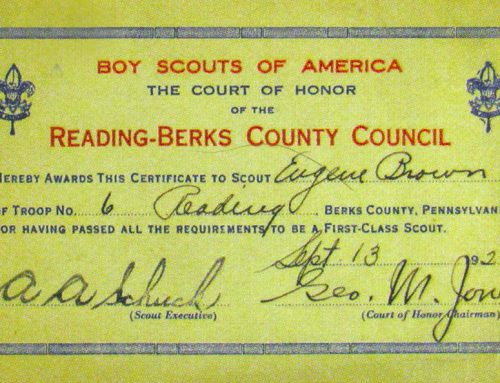As early as 1850, most of the outdoor entertainments were in parks shaded by huge trees with a thick covering of tan bark on the ground. Variety acts with pioneer gymnasts and acrobats, orchestra and band concerts, and choral organizations entertained enthusiastic gatherings whenever a program was scheduled.
One of the earliest parks was owned by Peter Steinel, occupying the north side of Penn Street below Tenth. In 1853 Peter Steinel removed his brush factory and residence from the east side of South Sixth near Penn to the north side of Penn below Tenth, the property having a front of 60 feet and a depth of 270 feet. There he located his brush factory, in a frame building, and opened a public house in an adjoining two-story structure, in part of which he resided.
There was a wagon road from Penn that passed alongside the factory into the large yard in the rear of the buildings, and he fitted up the yard for a summer garden and menagerie. Among his collection of wild beasts, in large cages, were lions and bears. He also had a number of cages in which were over 200 birds, among which were canaries, German robins, and other beautiful imported birds and a number of wild birds caught in the fields and on the mountains in the vicinity of Reading. Some of these birds were taught to whistle popular tunes.
Peter Steinel died in 1870, and the following year his widow and family removed to the northwest corner of Ninth and Walnut. Egidius Bach, a native of Luxemburg, Germany, became the landlord of the Penn Street wine house and menagerie, and he named the place “Luxemburg Park.” A few years thereafter William Walters took charge of the place, which was largely patronized, and he conducted it up to the time of his death there.
Andalusia Hall came into existence shortly after the Civil War when the Madeira family converted its commodious farmhouse to “a summer boarding house.” Andalusia Hall stood nearly opposite the entrance to Charles Evans Cemetery. In 1885, Julius E. Hertwig became proprietor. Andalusia Hall was an elongated brick structure that fronted on Centre Turnpike (now Centre Avenue). The site offered a fine view up the Schuylkill Valley and surrounding country. There was a “music shell” and accommodations for an audience of 2000 people. A pavilion was attached to the west side of the house and this was enclosed with glass during the winter so that theatrical performances could be given there. Hand concerts were programmed by Ringgold, Germania and Liberty Bands, and among the acts often related was Prof. Till’s Marionettes. In April 1891, James Hervey Sternbergh purchased the resort, razed it, and built his magnificent mansion – The Stirling – on the site. The site is now occupied by the “The Gables at Stirling Guest Hotel.”
Below: Andalusia Hall, Centre Avenue.

In 1875, Charles B. Miller bought a tract of uncultivated land in 1875 on the west side of the road leading from Perkiomen Avenue to the Mineral Spring (located near South Nineteenth Street), built an inn and dancing pavilion there, and opened a park.
The Reading Press Club and other organizations banqueted there and many citizens of Reading and their families visited this resort regularly. John Fahrbach, Theodore Breedy and Harry Whitman directed the orchestras for Charles Miller at this popular park and garden. Mr. Miller conducted the place over a quarter of a century, up to the time of his death, and he was succeeded by his sons and subsequently by other landlords.
The development of Pendora Park, which was in its heyday between 1907 and 1911, necessitated the removal of most of the improvements and attractions that once had been a part of Miller’s Family Park. In its last days, the old inn was known as the Pendora Hotel, 300 South 19th Street. A number of the workers hired to construct the Lindbergh Viaduct boarded there for the duration. It last operated around 1930. Thereafter it stood vacant until razed four years later.
Below: The Hotel at Miller’s Family Park became the Pendora Inn. This is how it looked in its final days.

About the same time that Miller’s Park opened, David P. Lash rented the Deininger mansion north of Union Street and east of Thirteenth, secured a hotel license, and opened a public house there. The former Deininger “farmhouse,” dubbed “Selwyn Hall” in 1883, is said to have been constructed in 1835. In the park surrounding the building he erected gymnastic paraphernalia, and the place became a popular resort. Many of the young men of Reading, and older ones, too, spent their Sundays there. Some evenings the place was also quite lively, and during fine weather Mr. Lash did a large business. At the instigation of the Rt. Rev. M. A. DeWolfe Howe, first bishop of the Episcopal Diocese of Central Pennsylvania and a Reading resident, the diocese bought the isolated “gentleman’s estate,” a 4.5-acre property, for $14,800, and created a military-type academy. This site is now a part of Albright College.
Below: Cadets at Selwyn Hall beside former Jonathan Ehrgot Deininger mansion.

Herman Floto established a park on South Ninth west of Laurel, which was for a number of years a popular resort. Musical programs were given by the Philharmonic Society, composed of musicians and vocalists organized and directed by Philip Bissinger. It was generally called “Floto’s Park.” Osmund Geier took charge of it in 1879 and conducted it five years, during which time he established a theatre there, which was largely attended.
His brother, Charles A. Geier, was his successor. He conducted the place a short time, and was succeeded by Christopher Ganster. Osmund Geier changed the name to “Fairview Park,” built a stone retaining wall along Laurel and made a number of other improvements at considerable expense. Singing societies and other social organizations frequently met there and the park was often crowded. The trees afforded a delightful shade in summer.
This park stood behind the Reading Brewery, and for a period had the most attractions of any of the local “resorts” until the establishment of Carsonia in 1896. For all that was there, surprisingly little survives to indicate to what degree the place was developed. The site was taken for enlargement of the brewery complex.
Below: Behind the trees in the left foreground is Fairview Park, which was behind the Reading Brewery. The cupola atop the park’s octagonal “grand pavilion” is visible in the center foreground.

Biddle’s Spring House, at Third and Chestnut Streets, became Lauer’s Garden in 1888. Edward Schuck became manager in the 1890s and it was at Lauer’s Garden that the famous Bard Brothers, world famous acrobats, began their career.
Reading spawned numerous acrobatic acts in the early part of the last century. Audiences in every major city and innumerable whistle-stops thrilled as Reading’s acrobatic daredevils performed breathtaking feats of tumbling, hand-balancing, and gymnastics.

In Reading years ago, any kid who ever dreamed of running away with a circus knew something about brothers Charles and Paul Fidler, Oscar E. Ramsey, and James E. Bard. When interviewed in 1958, James Bard was the only member of that troupe still living.
Before Bard joined the group in 1905, the team was known as the Three Melvins. He remained with them for a relatively brief period. James began his career as a solo performer, doing balancing tricks high above the ground on a slack wire. A natural fence-walker when a boy, he gave his first professional performance at age 18 in Lauer’s Garden.
Below: Lauer’s Original Brewery, 3rd and Chestnut, Reading, in 1846. “Lauer’s Garden Hotel” is on the right.

The Military Garden, on the east side of South Fourth below Laurel, was for over 50 years a popular place for holding celebrations, picnics, military displays and political meetings and dances. It was laid out by the late Major George L. Goodhart and embraced two acres. It was formally dedicated July 4, 1839, when James Buchanan, afterwards President of the United States, made a speech, although the place had been used before as a public resort. Some of the materials from the old court house were used to build the hotel that sat on the grounds. The land was given up for the Pennsylvania Railroad.
Below: Goodhart’s Military Garden and Hotel property boundaries are shown on this 1884 map.

In the early eighties, Casper Krug built Arion Garden on the east side of Seventh Street near Cherry. This was the site of the first Bijou theatre. The entertainment was short lived, due to risqué acts that were presented, and the policy was abandoned. Christian Mack then managed the Garden, to be followed by his son, George H. Mack and later by Edward Schuck. It was at Schuck’s Garden that William McCormack, then owner and publisher of the Reading Herald, entertained the Reading Newsboys and organized the Boys’ Brigade.
In 1884 Lauer’s Park, North Third near Elm Street, was the site for picnics, conventions, outdoor amusements and band concerts. The park was initially a wooded area located behind a hotel more on the order of a simple beer garden than a beauty spot for family picnics. In time, the grove evolved into a nicer affair with a pavilion, fountain, band stand, dancing hall, and more.
Below: Lauer’s Hotel and Brewery west side of North Third Street between Walnut and Buttonwood, Reading, PA.

One of the noteworthy events was the visit of Webber’s Marine Band from Berlin, Germany. On the first Monday in September of each year the “Caenstaetter Volkfest Verein” assembled, and fruits of the season were pyramided high in the air while the public paid homage to “Ceres,” the goddess of agriculture. In 1907 Lauer’s Park was converted into a ball park and became the home grounds for teams representing Reading in the Union, Atlantic, Tri-State, and Inter-State leagues. In 1943 a cyclone destroyed the park and it was never rebuilt.
Below: Lauer’s Park, looking northeast from the Second Street side, in the 1930s, when professional teams played ball here. To the right of the scoreboard one can see the roof of the “park hotel” that sat above the entrance to the Third and Elm vault entrance. In the background, behind second base, is the malt house of Deppen’s Brewery, erected in 1908 and 1909. The bleachers in Lauer’s Park were first built in 1907 to accommodate 300 people. Later the seating capacity was greatly enlarged.

Spring Garden at Tenth and Chestnut Streets, later to be known as Deppen’s Garden, was a popular site for parties. Many a male quartet harmonized their barber-shop chords in the early morning hours at the same site now occupied by Southern Junior High School.
Woodvale Park, at Twenty-third and Fairview, opened with a concert by the Germania Band and many Maennerchor Choral concerts were given at this popular resort. Amusement lovers will recall with pleasant memories the band concerts and musical programs scheduled at Mineral Springs Park, with its rustic band stand erected on the steep slope of Mt. Penn.
Groff’s Crystal Palace Swimming Park on the block between Sixteenth and Seventeenth and Perkiomen Avenue and Cotton Streets, had a winding stream and swimming pool near the Sixteenth and Cotton Street section. There was an old mill, a roller coaster, and other amusements at Groff’s Park. When the park was abandoned, Groff built the Crystal Palace at 744-746 Penn Street, and opened Groff’s Crystal Palace Gardens, with its tropical setting amid palms, fountains with pools of gold fish, and colorful tropical parrots and birds to add to the atmosphere.
Band concerts and dancing were popular at all of the mountain resorts, but these have all been destroyed or razed. The Neversink Mountain Hotel on Neversink Mountain near Point Lookout burned to the ground September 30, 1905; Mt. Penn Tower on Mt. Penn, at the top of the old Gravity Railroad, burned down April 23, 1923; The Highland House, at the top of the old incline railway above South Thirteenth Street, was destroyed by fire April 25, 1930; and the Klapperthal Pavilion, built about 1894 at a cost of $25,000, at the terminal of the Neversink Mountain Railroad, was finally razed. This was the largest pavilion ever built in the county, but due to lack of patronage, it was dismantled in 1903 and the lumber was sold to building contractors.
Below: The Neversink Mountain Hotel stood atop Neversink Mountain, directly south of 23rd and Perkiomen Avenue. The building was totally frame and was 388 feet long and 68 feet wide. It had accommodation for 300 guests. The structure was completed by June 18, 1892, and burned to the ground on Sept. 29, 1905.

Below: Mt. Penn Tower and Summit Hotel.

Below: Klapperthal Pavilion.

On Penn Commons, our own City Park, countless band concerts were given in the rectangular band stand which stood on the lawn above the lily pond. The old band stand was dismantled when the new band shell was erected in 1939.
Below: City Park Band Stand.

The most important milestone in early amusement parks dates back to Carsonia Park. Carsonia Park operated in Lower Alsace Township from 1896 to 1950. The park was constructed by the United Traction Company as a destination for its trolley service. Over the course of its existence Carsonia Park featured many rides and attractions. The roller coasters Jack Rabbit and Thunderbolt, The Airplane Ride, Dodgem Cars, Strato Ship, Castle of Mirth, The Pretzel, Shoot the Shoot, Cuddle Up, and a ferris wheel are just a few examples of what the park offered.
The Carsonia Pavilion, as it was called, stood in the wooded section of the Park between the carousel and the old toboggan or scenic railway. This was Reading’s first summer theatre and opened September, 1896, with a two weeks engagement of Simmons and Slocum’s Minstrels. The summer season of 1897 brought the Gonzalez Comic Opera troupe in a revival of Gilbert and Sullivan and other operettas. Lizzie Gonzalez was the prima donna and the principals included Frank Nelson, Frank French and John Young, later to be the star comedian in “The Little Cafe” on Broadway. During the first season, week stands were given of “Fra Diavolo,” “Chimes of Normandy,“ “Princess of Trebizonde,” “The Mascot,” “The Pirates of Penzance,’” “The Bohemian Girl” and “Girofle-Girofla.”
Below: The Carsonia Theatre, dating from 1897, was one of the park’s first attractions. By 1908, movies were being shown on a regular basis. This structure, originally called “the theatre pavilion,” was removed to make way for the Carousel.

During the second season, when Lizzie Gonzalez headed the Milton Aborn opera company on a coast-to-coast tour, Jennie Corea succeeded her as prima donna at the Park Theatre. A number of the Gilbert and Sullivan successes were repeated and, in addition, the company presented “The Bohemian Girl,” “The Queen’s Lace Handerchief,” “Olivette,” “Said Pasha,” and “Martha.” Simmons and Slocum’s Minstrels played return engagements and the following seasons were devoted to comic opera, minstrelsy and vaudeville.
During its last few seasons, until the building was demolished, the theatre was devoted to motion pictures.
The Casino to the north of Carsonia Park, below the Friedensburg Road was the last of the favorite pavilion sites. It opened June 17, 1906, and programmed dancing and musicals; and finally was converted into a roller skating rink.
Below: The Casino, erected in 1906, stood along present-day Carsonia Avenue until razed in 1933. For all but its last two years, the place was reached primarily by trolley. This view looks northward, toward Stony Creek Mills.

The park and garden era of Reading, PA was a colorful epoch in the history of our amusements, and a period that produced many musicians, gymnasts, acrobats and vaudevillians who gained fame behind the footlights in the years that were to follow.






Leave A Comment